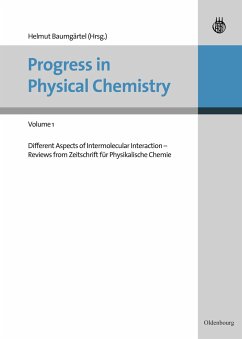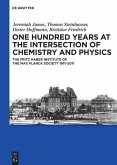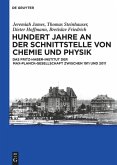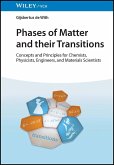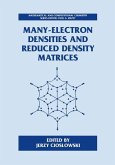Helmut Baumgärtel (Hrsg.)Progress in Physical Chemistry - Volume 1
Different Aspects of Intermolecular Interaction - Reviews from Zeitschrift für Physikalische Chemie
Herausgegeben:Baumgärtel, Helmut
1;Content;6
2;Preface;8
3;Attacking a Small Beast: Ar CO, a Prototype for Intermolecular Forces;10
3.1;1. Introduction;10
3.2;2. Quantum-mechanical description of Ar CO;15
3.2.1;2.1 The Ar CO Hamiltonian;15
3.2.2;2.2 Coriolis coupling;19
3.3;3. Theoretically predicted potential surfaces for Ar CO;20
3.4;4. Experimental results;22
3.4.1;4.1 High resolution vibrational-rotational spectroscopy;22
3.4.2;4.2 Ground state and propeller modes;24
3.4.3;4.3 Intermolecular modes: the intermolecular bending state;25
3.4.4;4.4 Coriolis decoupling;26
3.4.5;4.5 Intermolecular modes: the stretch;28
3.4.6;4.6 Intermolecular modes: combination bands;29
3.4.7;4.7 Coupling of intramolecular and intermolecular modes;30
3.5;5. Comparison between theoretical and experimental data;30
3.6;6. Semi-empirical fit of the potential surface;34
3.7;7. Perspectives;42
3.7.1;Acknowledgement;43
3.7.2;References;43
4;IR Spectroscopy of Microsolvated Aromatic Cluster Ions: Ionization- Induced Switch in Aromatic Molecule Solvent Recognition;46
4.1;1. Introduction;47
4.2;2. Experimental approach;49
4.3;3. Results and discussion;55
4.3.1;3.1 Complexes of acidic aromatic ions with nonpolar ligands;55
4.3.2;3.2 Complexes of bare aromatic hydrocarbon cations with polar ligands;70
4.4;4. Concluding remarks and outlook;82
4.4.1;Acknowledgement;84
4.4.2;References;84
5;Fluorescence Imaging of Reactive Processes;90
5.1;1. Introduction;90
5.2;2. Principles of LIF imaging;91
5.2.1;2.1 Fluorescence quenching;93
5.2.2;2.2 LIF in the gas phase;93
5.2.3;2.3 LIF in solutions;94
5.3;3. Experimental considerations;98
5.3.1;3.1 Set-up for gas phase diagnostics;98
5.3.2;3.2 Microscopic LIF imaging;102
5.4;4. Examples: gas phase chemistry;105
5.4.1;4.1 Reaction rate imaging;105
5.4.2;4.2 Turbulence/ chemistry interactions;107
5.5;5. Examples: biological applications;108
5.5.1;5.1 Protein mobility in live cells;109
5.5.2;5.2 Protein protein interactions;112
5.6;6. Conclusions;115
5.6.1;Acknowledgement;115
5.6.2;References;115
6;Modern High Resolution NMR for the Study of Structure, Dynamics and Interactions of Biological Macromolecules;118
6.1;1. Introduction;118
6.2;2. Protein structure and dynamics by conventional liquid NMR;122
6.2.1;2.1 Homonuclear 2D NMR;122
6.2.2;2.2 Heteronuclear 3D and 4D NMR;123
6.2.3;2.3 Protein structure determination;125
6.2.4;2.4 Protein dynamics;132
6.2.5;2.5 Recent technological advances;133
6.3;3. Deuteration and TROSY push the molecular weight limit of solutionNMR;135
6.4;4. Residual dipolar couplings provide global structure restraints;139
6.5;5. Exploring protein ligand interactions by solution NMR;142
6.5.1;5.1 Structure of protein complexes;142
6.5.2;5.2 Localization of interaction sites;148
6.5.3;5.3 Ligand screening by NMR;151
6.5.4;Acknowledgement;154
6.5.5;References;155
7;Time-Resolved ESCA: a Novel Probe for Chemical Dynamics;166
7.1;1. Introduction;166
7.2;2. Sources for ultrashort XUV pulses;168
7.2.1;2.1 Laser-bases sources;170
7.2.2;2.2 Synchrotron radiation sources;173
7.2.3;2.3 Free-electron lasers;174
7.3;3. Applications of XUV pulses in time-resolved studies;175
7.3.1;3.1 Electron spectroscopy with synchrotron radiation;175
7.3.2;3.2 Electron spectroscopy with high harmonics;176
7.3.3;3.3 Other time-resolved methods;179
7.4;4. Exploring the limits of temporal resolution;180
7.5;5. Summary and outlook;183
7.5.1;References;184
8;Kinetics of Electrochemical Phase Formation in Two- Dimensional Systems;188
8.1;1. Introduction;188
8.2;2. Nucleation and growth kinetics in two dimensional systems;191
8.2.1;2.1 General formalism;193
8.2.2;2.2 Nucleation;193
8.2.3;2.3 Growth kinetics;205
8.2.4;2.4 Avrami theorem;209
8.3;3. Combined adsorption and phase transformation kinetics;210
8.3.1;3.1 Parallel adsorption and phase transformation (mechanism (1));211
8.3.2;3.2 Phase transformation according to a consecutive mechanism;214
8.4;4. Summarizing;221
9;Factors

